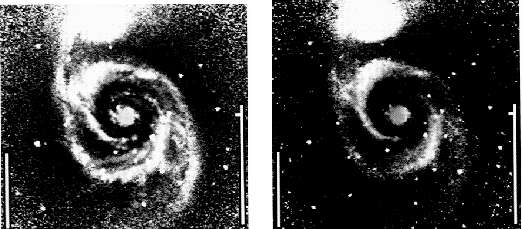Next: Density Wave Theory Up: Galactic Scale Star Formation Previous: Toomre's Value Contents
 |
Figure 3.10 shows the ![]() - (left) and
- (left) and ![]() -band images of M51.
-band images of M51.
![]() -band light originates from the massive early type stars.
Although the image taken in
-band light originates from the massive early type stars.
Although the image taken in ![]() -band shows a number of spiral arms,
that of
-band shows a number of spiral arms,
that of ![]() -band shows clearly two arms.
The
-band shows clearly two arms.
The ![]() -band light seems to come from mainly less-massive long-lived stars,
while the
-band light seems to come from mainly less-massive long-lived stars,
while the ![]() -band light is essentially coming from the massive short-lived stars which are
formed in the spiral arm.
On the contrary, the less-massive stars are not necessarily born in the spiral arm.
This suggests that there are two kinds of spiral patterns:
one is made by stars (mainly less-massive) and the other is the gaseous spiral arm where
massive stars are born and contribute to the
-band light is essentially coming from the massive short-lived stars which are
formed in the spiral arm.
On the contrary, the less-massive stars are not necessarily born in the spiral arm.
This suggests that there are two kinds of spiral patterns:
one is made by stars (mainly less-massive) and the other is the gaseous spiral arm where
massive stars are born and contribute to the ![]() -band image.
-band image.
In this section, first, we will briefly describe the density wave theory which explains the
former spiral pattern in the stellar component.
You will find the amplitude of the spiral pattern in stellar component is not so large.
However, the response of gaseous components (HI and H![]() gas) to the spiral density wave
potential with small amplitude is much more nonlinear than that of the stellar component
and a high-contrast spiral pattern appears in the gaseous component .
gas) to the spiral density wave
potential with small amplitude is much more nonlinear than that of the stellar component
and a high-contrast spiral pattern appears in the gaseous component .
Kohji Tomisaka 2012-10-03